General Information
| Other name(s): | Niagara Falls International Rainbow Bridge |
|---|---|
| Beginning of works: | 4 May 1940 |
| Completion: | 1 November 1941 |
| Status: | in use |
Project Type
| Structure: |
Deck arch bridge |
|---|---|
| Function / usage: |
Road bridge |
| Material: |
Steel bridge |
| Structure: |
Two-hinged arch bridge |
| Plan view: |
Structurae Plus/Pro - Subscribe Now! |
| Support conditions: |
for registered users |
Awards and Distinctions
| 1941 |
award winner
for registered users |
|---|
Location
| Location: |
Niagara Falls, Niagara County, New York, USA Niagara Falls, Ontario, Canada |
|---|---|
| Crosses: |
|
| Replaces: |
Honeymoon Bridge (1898)
|
| Coordinates: | 43° 5' 24.27" N 79° 4' 4.38" W |
Technical Information
Dimensions
| main span | 286 m | |
| total length | 441.96 m |
Materials
| arch |
steel
|
|---|---|
| deck of main bridge |
steel
|
| piers on arch |
steel
|
Chronology
| 4 May 1940 | Construction begins |
|---|---|
| 1 November 1941 | Official opening |
Excerpt from Wikipedia
The Niagara Falls International Rainbow Bridge, commonly known as the Rainbow Bridge, is an arch bridge across the Niagara River gorge. It connects the cities of Niagara Falls, New York, United States (to the east), and Niagara Falls, Ontario, Canada (west).
Construction
The Rainbow Bridge was built near the site of the earlier Honeymoon Bridge, which collapsed on January 27, 1938, due to an ice jam in the river. A joint Canadian and American commission had been considering a new bridge to replace it, and the collapse added urgency to the project.
A design by architect Richard (Su Min) Lee was chosen (and used again for the Lewiston-Queenston Bridge, approximately 10 kilometres (6 mi) downriver). The bridge's Rainbow Tower and Canadian plaza are the work of Canadian architect William Lyon Somerville. King George VI and Queen Elizabeth, during their visit to Niagara Falls as part of the 1939 royal tour of Canada, dedicated the site of the Rainbow Bridge; a monument was erected to commemorate the occasion. Construction began in May 1940. The bridge officially opened on November 1, 1941.
The origin of the bridge's name is unknown, with one possible source being T. B. McQuesten, then chairman of the Niagara Parks Commission. An engraving on the Canadian side of the bridge includes a biblical quote from the Book of Genesis which references a "bow in the clouds." Regardless of its origin, the NRBC used the name as early as March 1939.
Description and specifications
The New York State Department of Transportation designates the bridge as NY 955A, an unsigned reference route, while the Ontario Ministry of Transportation designates it as part of Highway 420 (and the original routing of the Queen Elizabeth Way), even though it is separated from the rest of the route by a regional road. On the American side, a number of state and national routes end at a set of intersections in front of the bridge. New York routes 104 and 384, as well as the northern section of the Robert Moses State Parkway, all terminate at the final intersection before the bridge, and none of the designations passes onto the bridge. U.S. Route 62 terminates two blocks north at route 104, which then continues to the bridge. The Rainbow Tower, part of the plaza complex on the Canadian side, houses a large carillon, which plays several times daily.
The bridge permits no commercial trucks; the nearest border crossing for these is the Lewiston-Queenston Bridge.
The toll to cross the bridge for each pedestrian and bicycle is $1.00 US or CAD, and $4.00 US or $5.50 CAD for automobiles as of January 2021. Car tolls are collected when leaving the United States. Pedestrian toll is collected by an automatic turnstile when leaving Canada, payable in U.S. or CAD quarters or $1 CAD 'loonies'. Change machines are available from $1 and $5 US bills and $1 (loonies) and $2 (toonies) Canadian coins.
Text imported from Wikipedia article "Rainbow Bridge (Niagara Falls)" and modified on April 6, 2021 according to the CC-BY-SA 4.0 International license.
Participants
- Waddell and Hardesty
- Edward P. Lupfer (consulting engineer)
Relevant Web Sites
Relevant Publications
- (1994): Brücken / Bridges. Ästhetik und Gestaltung / Aesthetics and Design. 4th edition, Deutsche Verlags-Anstalt, Stuttgart (Germany), pp. 235-237.
- (1901): The Niagara Falls and Clifton Steel Arch Bridge. In: Minutes of the Proceedings of the Institution of Civil Engineers, v. 144, n. 1901-2 ( 1901), pp. 69-94.
- (1999): Tierra sobre el agua. Visión histórica universal de los puentes. Colegio de Ingenieros de Caminos, Canales y Puertos, Madrid (Spain), pp. 335-336.
- About this
data sheet - Structure-ID
20000505 - Published on:
16/11/1999 - Last updated on:
24/06/2022

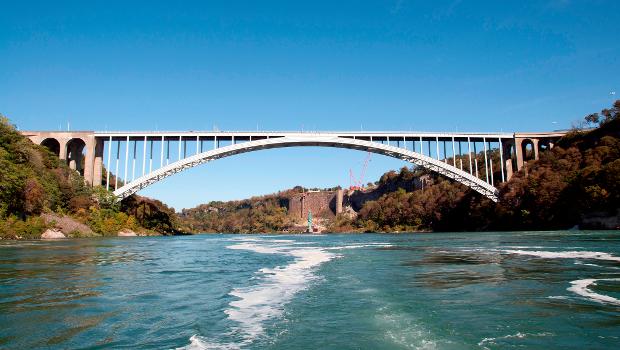
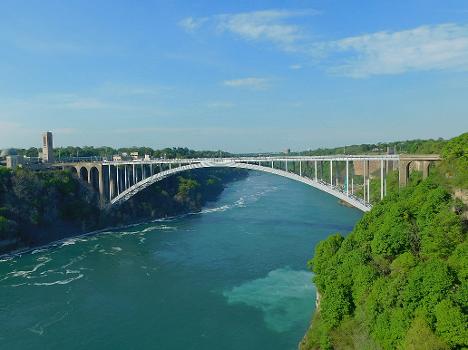
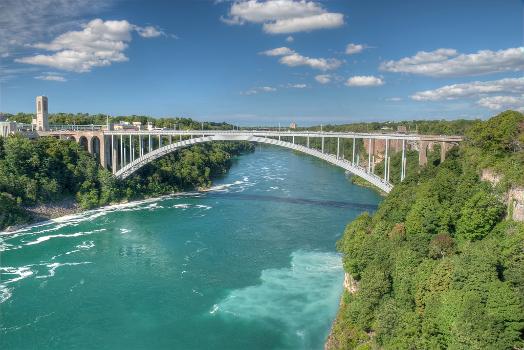
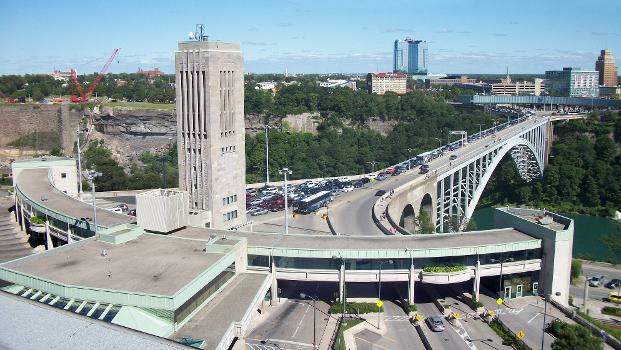
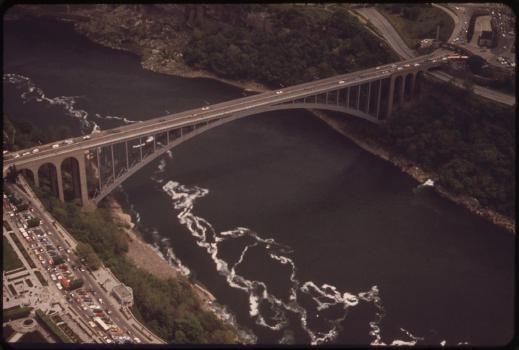
.jpg)



